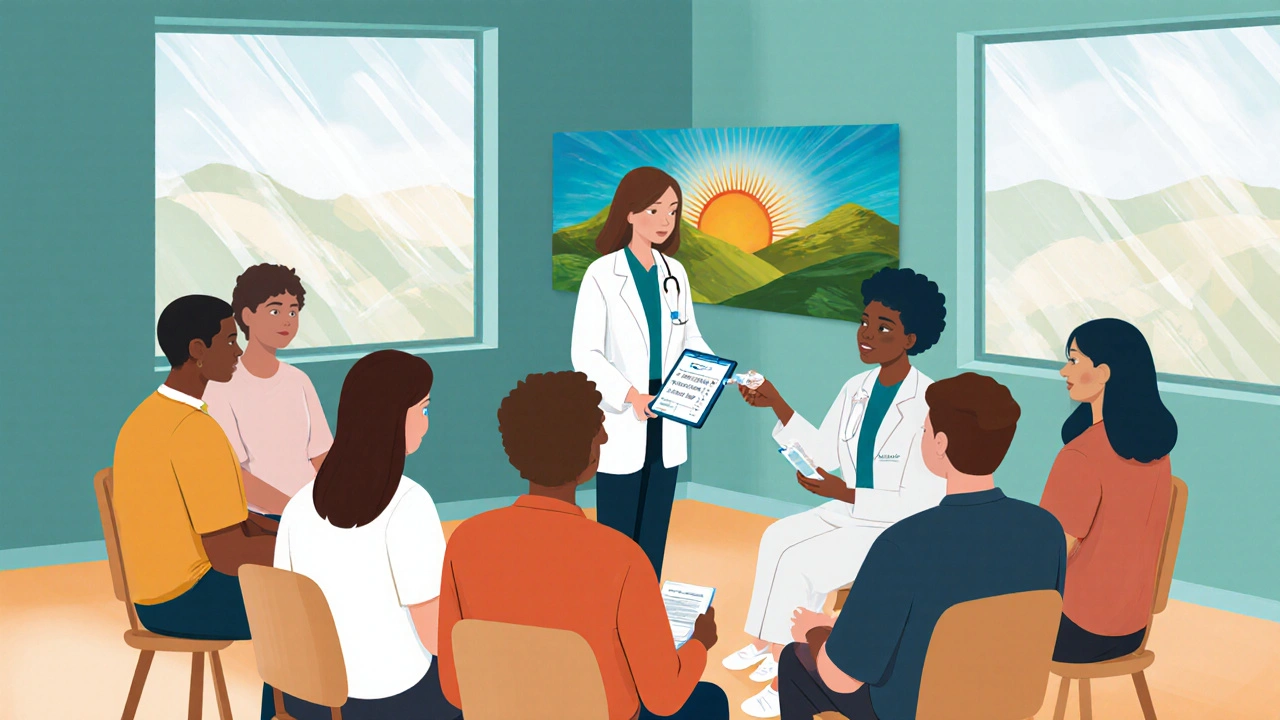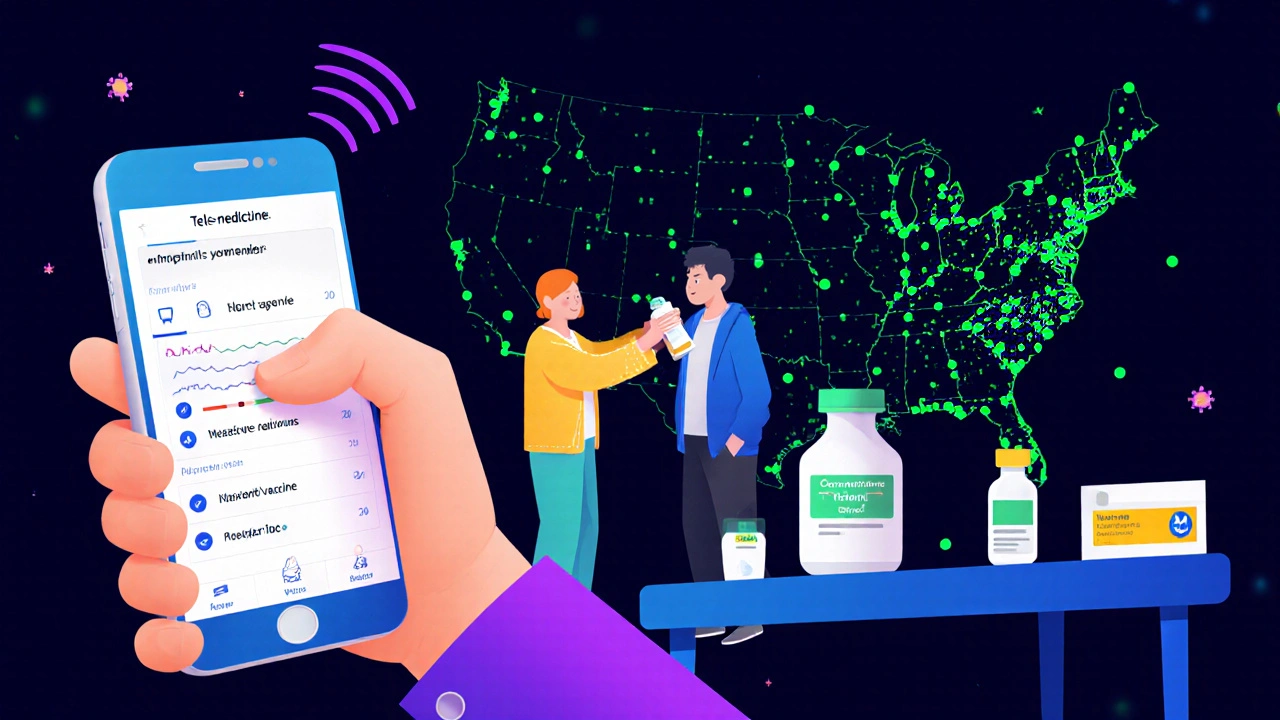Opioid Addiction Epidemic: A Comprehensive Overview
 Oct, 11 2025
Oct, 11 2025
Opioid Epidemic Impact Calculator
Enter values and click Calculate to see projected impact
Key Takeaways
- The United States now records more than 100,000 opioid‑related deaths each year.
- Prescription opioids and illicit heroin/fentanyl drive the majority of new addictions.
- Medication‑assisted treatment (MAT) reduces relapse risk by 50‑80% when combined with counseling.
- Naloxone distribution programs have cut community overdose mortality by roughly one‑third.
- Effective prevention hinges on prescriber education, safe‑storage practices, and early screening.
When you hear the term opioid addiction is a chronic, relapsing brain disorder characterized by compulsive opioid use despite harmful consequences, the image that pops up is often a grim statistic. But behind the numbers are real people, families, and whole health systems struggling to keep up. This overview breaks down the scale of the crisis, the biology that fuels it, the policies shaping it, and the tools that actually work on the ground.
How Big Is the Problem?
Data from the CDC (Centers for Disease Control and Prevention) show a steady climb since the late 1990s. In 2023, the U.S. recorded 106,000 opioid‑related deaths, marking a 12% increase over the previous year. Annual emergency‑room visits for non‑fatal overdoses topped 320,000. Roughly 2% of the adult population (about 5million people) meet clinical criteria for an opioid use disorder (OUD).
Geographically, rural Appalachia, the Midwest, and parts of New England see the highest per‑capita death rates, while urban centers wrestle with fentanyl‑contaminated heroin markets. The epidemic is not confined to the United States; Canada, the United Kingdom, and Australia report rising prescription‑opioid misuse, signaling a global spill‑over.
What Fuels the Epidemic?
The roots are tangled, but three pillars dominate:
- Prescription Opioids: Aggressive marketing in the early 2000s convinced many physicians that opioids were safe for chronic pain. The FDA (Food and Drug Administration) later tightened guidelines, yet millions of pills remain in circulation, often diverted for non‑medical use.
- Illicit Opioids: When prescription supplies tightened, many users shifted to heroin or synthetic fentanyl. Fentanyl is 50-100 times more potent than morphine, and even a microgram can be lethal.
- Socio‑economic Stressors: Unemployment, limited access to mental‑health care, and social isolation increase vulnerability, especially in communities hit hard by de‑industrialization.
Biologically, opioids bind to mu‑receptors in the brain, flooding the reward system with dopamine. Repeated exposure rewires neural pathways, prompting cravings that outpace rational decision‑making.

Diagnosing and Measuring Opioid Use Disorder
Clinicians rely on the DSM‑5 criteria, which require at least two of eleven symptoms within a 12‑month period. Common signs include unsuccessful attempts to cut down, continued use despite health problems, and spending excessive time obtaining the drug.
Screening tools such as the Opioid Risk Tool (ORT) and the Brief Intervention, Referral, and Treatment (SBIRT) framework help primary‑care providers flag at‑risk patients early. Early identification is crucial; the sooner treatment starts, the higher the chance of remission.
Effective Treatment Pathways
Treatment isn’t a one‑size‑fits‑all. Evidence points to a combination of medication‑assisted treatment (MAT) and psychosocial support as the gold standard. The three FDA‑approved medications are:
| Medication | Mechanism | Effectiveness (relapse reduction) | Administration | Common Side Effects |
|---|---|---|---|---|
| Methadone | Full mu‑opioid agonist | 60‑80% | Daily oral dose at certified clinic | Constipation, QT prolongation |
| Buprenorphine | Partial mu‑opioid agonist | 50‑70% | Weekly or monthly sub‑lingual film/tablet | Headache, mild withdrawal symptoms |
| Naltrexone | Opioid antagonist | 30‑50% (when adherence high) | Monthly intramuscular injection or daily pill | Liver enzyme elevation, nausea |
Research from the National Institute on Drug Abuse (NIDA) shows that patients on MAT who also receive counseling have a 40% higher chance of staying drug‑free for at least a year compared with counseling alone.
Beyond medication, supportive services-housing assistance, employment programs, and peer recovery groups-address the social determinants that often trigger relapse.
The Role of Naloxone in Saving Lives
Naloxone is an opioid antagonist that rapidly reverses respiratory depression in an overdose. Community‑wide distribution programs have become a cornerstone of harm reduction.
Since 2018, U.S. states that mandated naloxone availability in pharmacies have seen a 30‑35% drop in fatal overdoses. Over‑the‑counter formulations (nasal sprays and auto‑injectors) empower family members and bystanders to act quickly, buying crucial minutes for emergency services.

Prevention Strategies That Actually Work
Prevention starts with prescribers. The CDC’s 2022 guideline recommends prescribing the lowest effective dose and limiting therapy to three days or less for acute pain. Prescription‑monitoring programs (PMPs) cross‑check patient histories, reducing “doctor shopping.”
Public‑health campaigns focused on safe storage (lockboxes) and proper disposal (take‑back events) cut accidental exposure among children and teens. School‑based curricula that teach the neurobiology of addiction in plain language have shown a modest but statistically significant decline in misuse rates.
Finally, policy‑level actions-expanding insurance coverage for MAT, legalizing standing orders for naloxone, and de‑criminalizing possession of small amounts in favor of treatment-create an environment where recovery is possible.
Looking Ahead: What Will 2026 Bring?
Emerging data suggests that tele‑medicine‑delivered MAT will become mainstream, especially in rural underserved areas. Mobile‑app platforms that combine medication reminders with peer support chat rooms are already showing promising engagement metrics.
On the research front, novel long‑acting formulations of buprenorphine (implantable or monthly injectable) aim to improve adherence and reduce diversion. Meanwhile, vaccine‑based approaches that elicit antibodies against fentanyl are in Phase II trials-if successful, they could add a preventive layer for high‑risk populations.
Ultimately, the epidemic’s trajectory hinges on whether we can synchronize medical, social, and legal levers. The numbers are sobering, but the tools at our disposal are more effective than ever.
Frequently Asked Questions
What is the difference between addiction and dependence?
Dependence means the body adapts to a drug, leading to withdrawal symptoms when use stops. Addiction adds compulsive seeking and use despite harms. You can be dependent on a medication without being addicted, but most people with opioid use disorder experience both.
Can someone recover from opioid addiction without medication?
Recovery is possible, but relapse rates are significantly higher without medication‑assisted treatment. Studies show a 40‑60% relapse risk within a year for counseling‑only approaches, compared to 20‑30% when MAT is added.
How does naloxone work, and can it be used repeatedly?
Naloxone binds to opioid receptors faster than most opioids, kicking them off and restoring normal breathing. It can be administered multiple times if the opioid involved has a long half‑life, but medical help should follow immediately.
Is fentanyl only found in illegal drugs?
Pharmaceutical fentanyl is prescribed for severe cancer pain, but most overdose deaths involve illicitly manufactured fentanyl mixed into heroin or counterfeit pills. The illicit version is far cheaper and more potent.
What steps can a family take if they suspect a loved one is addicted?
Start with a non‑judgmental conversation, encourage a medical evaluation, and explore local MAT providers. Many communities have 24‑hour helplines that can guide families to resources and support groups.

Joshua Logronio
October 11, 2025 AT 13:18You ever notice how the pharma giants seem to pop up right when the stats get scary? It's almost like they're waiting for the perfect moment to push another "solution" down our throats. They love to talk about naloxone and MAT, but the real money flows through endless prescription cycles. I think there's a hidden agenda they're not telling us about, and most folks just swallow it whole. Stay woke, buddy.
Nicholas Blackburn
October 16, 2025 AT 05:00The numbers in this post are basically a smokescreen, and anyone with half a brain can see the sloppy grammar they hide behind. They throw around terms like "opioid‑related deaths" without even bothering to use the proper commas, which is a red flag for the lazy. If you actually read the data, you'll notice the inconsistencies that the author conveniently ignores. It's a classic case of style over substance, and it's infuriating. Wake up and read the fine print, or keep being duped.
Dave Barnes
October 20, 2025 AT 21:30There is a paradox in the way we treat OUD: we call it a disease yet punish the sufferers with stigma. It reminds me of an ancient paradox where the solution becomes part of the problem itself. While the science is solid, the implementation feels like a half‑baked philosophy. The author skims the surface, but the deeper currents are where the real battle lies.
We need to question the narratives we accept.
Kai Röder
October 25, 2025 AT 13:26From a community health perspective, the integration of MAT with counseling yields the most sustainable outcomes. It’s not just about dispensing medication; it’s about building trust and offering hope. Programs that include housing assistance and peer support have shown measurable reductions in relapse rates. Let’s keep those holistic models at the forefront of policy discussions.
Brandi Thompson
October 30, 2025 AT 05:40When you look at the raw data you see a cascade of numbers that tell a story far beyond what the brief summary suggests. The rise in overdose deaths is not merely a statistic but a symptom of systemic neglect and fractured social fabrics that have been eroded over decades. The author mentions naloxone distribution as a silver bullet yet fails to address the socioeconomic determinants that sustain the crisis. Lack of affordable housing, dwindling employment opportunities, and fragmented mental health services create a perfect storm where opioids become a coping mechanism for many. Moreover the emphasis on medication‑assisted treatment, while evidence‑based, often overlooks the stigma that patients face when accessing these services, which in turn reduces adherence and leads to higher relapse rates. The interplay between prescription practices and illicit markets is another layer that deserves deeper analysis, as stringent prescribing guidelines sometimes push vulnerable users toward more dangerous street‑level fentanyl. The policy recommendations presented are well‑intentioned but lack the granular detail needed for implementation at the local level. For instance, the suggestion to expand PDMPs must be paired with training for clinicians to interpret data responsibly, otherwise you risk creating a punitive environment that discourages legitimate pain management. In addition the article does not sufficiently explore the role of cultural attitudes toward pain and medication, which vary widely across different communities and influence both prescribing patterns and patient behavior. A truly comprehensive approach would integrate community‑led initiatives, such as peer recovery coaches, with robust public health infrastructure. Finally the call for more research, while valid, should be directed toward innovative interventions like vaccine‑based prophylaxis, which could revolutionize prevention if successful. In short the epidemic is a multifaceted problem that requires solutions as complex as the forces that created it, and any single‑dimensional strategy will fall short.
Chip Hutchison
November 3, 2025 AT 21:53It’s crucial that we remember each statistic represents a human story. Empathy and cultural sensitivity go hand‑in‑hand with evidence‑based interventions. Let’s keep the conversation inclusive and solution‑focused.
Emily Moody
November 8, 2025 AT 14:06Our nation’s resolve is being tested by a crisis that threatens the very fabric of our society. The opioid scourge is not just a health issue; it’s an existential battle for the soul of America. We must mobilize every resource-policy, law enforcement, and patriotic community action-to crush this menace. Failure is not an option, lest we betray the legacy of those who built this great land. The time for half‑measures has passed; it’s full‑force or nothing.
Prateek Kohli
November 13, 2025 AT 06:20Hey folks, the data is heavy but we can tackle it together 😊. It’s clear that multi‑pronged approaches work best, so let’s keep sharing resources and ideas. If you’re in a position to help, even a small act can ripple out. Stay hopeful, stay kind.
Noah Seidman
November 17, 2025 AT 22:33While the long‑winded analysis tries to paint a grim picture, it conveniently ignores personal responsibility. The moral hazard created by endless hand‑outs of naloxone and cheap MAT is evident: people feel invincible and keep abusing. Our society must re‑assert the value of discipline over dependency. If we keep coddling addicts, we’ll never see real change. It’s time to demand accountability from both users and providers.
Anastasia Petryankina
November 22, 2025 AT 14:46Ah, the lofty philosophical musings about paradoxes-how original. One might think the author is reaching for profundity, yet ends up sounding like a textbook that tried too hard. Such pretentiousness makes the reading experience feel contrived. Perhaps a dash of humility would improve credibility.
Tim Ferguson
November 27, 2025 AT 07:00At the end of the day, the opioid crisis is a problem we can solve with common sense. Simple steps like proper prescribing and community outreach go a long way. Overcomplicating it with jargon only confuses people. Let’s stick to what works.
Noah Cokelaere
December 1, 2025 AT 23:13Interesting take, but I can’t help noticing the easy‑going vibe you keep dropping. It’s almost like you’re watching the whole thing from a distance, sipping coffee. Still, the observation that we need more data is spot‑on. Keep the energy up, though-this is serious.
Ashley Helton
December 6, 2025 AT 15:26Sure, because blaming pharma solves everything.
Brian Jones
December 11, 2025 AT 07:40Well, that’s a concise way to put it, but let’s unpack it a bit, shall we? First, attributing the whole crisis to a single factor oversimplifies a complex public‑health emergency. Second, the data suggests multiple intersecting causes, including prescribing practices, socioeconomic stressors, and illegal drug markets. Third, constructive dialogue should focus on solutions rather than knee‑jerk blame. Finally, collaboration across sectors is essential for meaningful progress, and every voice-yes, even the short ones-adds to the conversation.